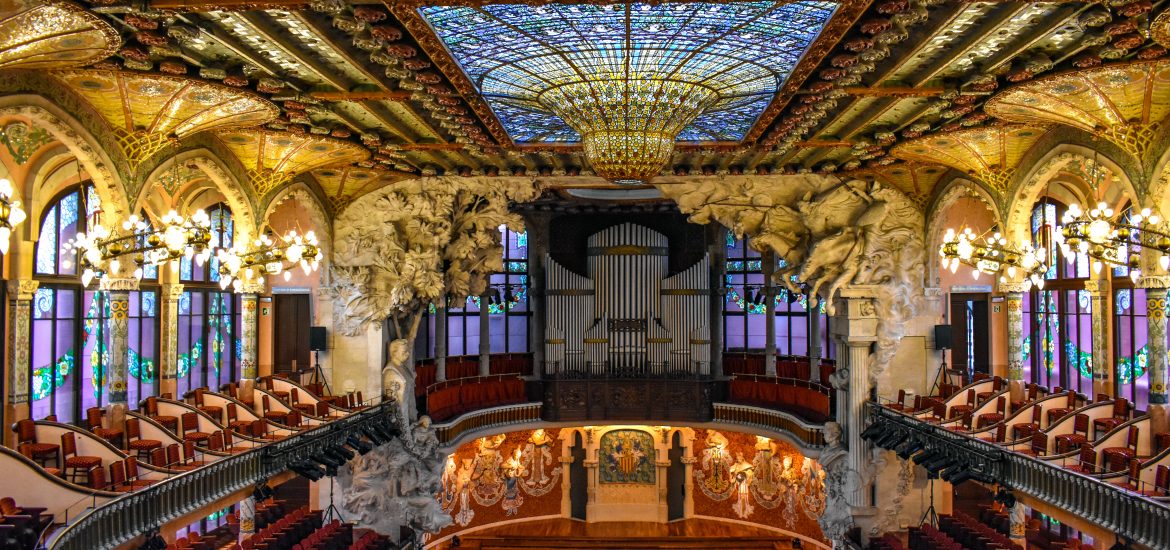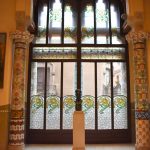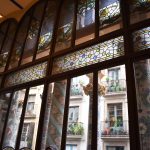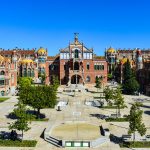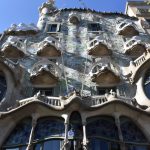As the UNESCO comments:
Palau de la Música Catalana and Hospital de Sant Pau, Barcelona. These are two of the finest contributions to Barcelona’s architecture by the Catalan art nouveau architect Lluís Domènech i Montaner. The Palau de la Música Catalana is an exuberant steel-framed structure full of light and space, and decorated by many of the leading designers of the day. The Hospital de Sant Pau is equally bold in its design and decoration, while at the same time perfectly adapted to the needs of the sick.
巴塞罗那的帕劳音乐厅及圣保罗医院。作为建筑界新秀的加泰罗尼亚建筑师蒙塔奈尔对于巴塞罗那的建筑有两项最出色的贡献,即帕劳音乐厅和圣保罗医院。帕劳音乐厅由巨大的钢架结构组成,光线充足,空间开阔,由当时许多顶尖设计师进行内部装饰。圣保罗医院的设计和装饰同样大胆创新,同时它也尽善尽美地适合病人们的需求。
Although situated on the narrow streets like this (as shown below), this music hall is one of the world’s most exceptional Art Nouveau gems. Don’t underestimate the Palau de la Música Catalana just by where it is located. Trust me, there is a new world in it.
It’s probably rather difficult to imagine the inside from the outside, but I can assure you there’s a huge contrast. Thanks to Domènech i Montaner, it is not only a landmark building and one of the most popular tourist attractions in Barcelona but also one of the most representative examples of Catalan Art Nouveau architecture (Modernista architecture).
This music hall was built between 1905 and 1908 during the modernista building boom, on the site of a former convent in the district of Sant Pere, initiated by the Orfeó Català, the choral society founded in 1891. The construction was commissioned to Lluís Domènech i Montaner, who turned it into one of his most representative works and a key figure of Modernisme. What’s worth noticing is that, built as home for the Orfeó Català, this project was totally sponsored by public donations, including large subscriptions from some wealthy industrialists. In other words, this is a music hall built by the people and for the people, thus playing an essential role in the cultural and social life of Catalonia.

Palau de la Música Catalana has gained its status and reputation today not only because of its outstanding historical and architectural value and perfect state of conservation, but also because of its quality and prestige of musical and social events and commitment to welcome all types of music all over the world. Do you know that every year more than half million people attend over 300 concerts here?
First of all, as the greatest modernista jewel, let’s take a look at the architectural side of this Palau. It is made from steel and brick with the application of decorative elements such as sculpture, stained glass and ceramics. Even before entering, you can already notice these features from the façades. However ,this building wasn’t built to show off how lavishly decorated it could be. Instead it was built as home to the choral society to hold concerts. If the function of the building is ignored, then the task of the architect will surely fail. Under this guideline, another masterpiece was born, again combining beauty and practicality. Similar to the time when Domènech i Montaner kept the needs of the patients and of the medical staff in mind when commissioned to build the Hospital de Sant Pau, he bore in mind the function of the Palau as a concert hall all the time while designing it. As a result, he constructed a large rationalist building and thanks to the steel structure, he was able to free up floors and walls to have enough space to create the perfect acoustics and of course to decorate it.
Secondly, let’s take a look at its practical role as a music hall. Nowadays we always pay credit to the architect who designed and built this building. However, without the initiation of the Ofeó Català or the contributions of the people, this project would never have been completed. Well, who is this Ofeó Català then? The Ofeó Català is the origin of this music hall, an amateur choir group founded in 1891 and was directed by Richard Strauss, Camille Saint-Saëns, Felix Weintgartner and Pau Casals in its early stage. In its more recent history, it’s been directed by Mstislav Rostropovich, Zubin Mehta, Lorin Maazel and so on. Speaking of which, the Rehearsal Hall of the Ofeó Català will be the first stop of your guided tour. It was here that the first stone of the Palau was laid in 1905.
As commented by Simon Halsey, the artistic director of the Orfeó Català Choirs and artistic adviser of Palau de la Música Catalana:
“The Orfeó Català is a choir extremely important in the history of Catalonia. I know of no other choir that clings both local and national awareness. Then there is the fascinating story of repertoire, locally, regionally and internationally and we will continue to expand. Just think of all our ancestors who invest in them so that we could enjoy the moment, and now it is our job to do everything possible to create a vibrant future!”


1. Practical information
Please note that there are no self-guided tours in Palau de la Música Catalana. If you wanna visit it, you have to join a guided tour organized by this concert hall.
1.1 Schedule of the guided tours
The tours are arranged every 30 mins:
- Daily: from 10:00 to 15:30
- Easter and July: from 10:00 to 18:00 (Consult dates)
- August: from 9:00 to 6:00 (Consult dates)
- Other times: consult availability by contacting (email: visites@palaumusica.cat)
The tours are available in five Languages: Catalan, Spanish, French, Italian and English and last 55 minutes.
- If you are buying your ticket on site, you can see on a big screen next to the ticket office when the tours in your chosen language will be begin on that day and how many places are left for certain tour.
- If you are booking your ticket online, you can choose the guided tour in your preferred language and then choose the date and time of your visit. (Please click here to book your ticket from the official website.)
1.2 Various ticket types and prices
1.2.1 General prices for simple guided tours (no concert included)
- Individual rate: 18 €
- Advance purchase rate: 14.40 € (purchase 21 days in advance)
- Catalonia resident rate: 10 € (only at the Ticket Office)
- Free: children under 10 years (inclusive), accompanied by a family member
- Free: Cchildren with the card Super3 (only at the Ticket Office)
1.2.2 Discounted prices for simple guided tours (no concert included)
- Family Pack discount for members of the same family (parents and children): 50 €
- Students, pensioners and unemployed people: 11 €
- 20% discount on the individual rate for: Groups (25 people), Aerobus, Barcelona Bus Turístic, Barcelona Card, City Tours, Ruta del Modernismo, Walking Tours.
Wanna make your visit to Palau de la Música Catalana more exciting? There are different packages which include more experiences (such as a concert) in addition to discovering the architecture of the Palau. For example (please click on them to know more information or to book tickets):
- Guided tour & Concert “Motets from Weimar”
- Guided tour + piano miniconcert
- Special visit La Mercè de Barcelona (a guided tour of the Palau combined with a short piano recital of 15 minutes)
Palau de la Música Catalana also organizes private visits for individual clients and groups subject to the availability of space. For example (please click on them to know more information but if you wanna book tours as following you have to consult prices and availability either by phone: +34 902 475 485 or by email: visites@palaumusica.cat):
Please note that:
- In order to get the Family Pack discount, 4 to 6 members must present at the box office their family book or identity cards as proof.
- The special tickets and discounts only apply at Palau de la Música box offices. Relevant documents must be presented.
- Guided tours may be altered from the usual route or cancelled in case of conflict with concerts.
- Be on time because after the tour has started no new guests will be allowed to join in.
- No smoking, no food or drink is allowed inside the auditorium.
- Cloakroom service and left luggage service are not available.
1.3 How to buy tickets
1.3.1 Online
As I mentioned above, you can buy tickets online (click here) for simple guided tours (no concert included) or combined guided tours but not for private visits.
1.3.2 At Box Offices of Palau de la Musica Catalana
- Address: C/Palau de la Música, 4-6
- Opening hours: Monday to Saturday: from 9:30 to 21:00. Sunday and holidays: from 10:00 to 15:00 and two hours before concerts.
- Address: C/Sant Pere Més Alt, s/n
- Opening hours: from 9:30 to 15:30
1.3.3 By phone:
- Number: +34 902 475 485
- Opening hours: Monday to Friday from 9:30 to 14:30
1.3.4 By email:
Request for information, individual bookings or group bookings by email: visites@palaumusica.cat
1.3.5 At Tiquet Rambles
Address: Palau de la Virreina (La Rambla 99)
1.4 How to get there
Address: C/ Palau de la Música 4-6, 08003 Barcelona, Spain
Metro:
- L1, L4 to station Urquinaona
- L3 to station Plaça Catalunya or Liceu
Bus: V15, V17, 45
Barcelona Tourist Bus (route north and south): Stop Casa Batllo – Antoni Tàpies Foundation
City Tours (Tours Barcelona): Stop 2, Gothic.
2. Explore the greatest Modernista jewel




First of all I’d like to show you the general route of your guided tour. The tour starts in the Rehearsal Hall of the Orfeó Catala, where as I said, the first stone was laid in 1905. It is also here that the choir has been rehearsing for more than 100 years. After watching a short movie in the Rehearsal Hall, you will climb up the grand staircase and visit the Lluís Millet Hall, from where you can go out to the large balcony filled with columns decorated with all kinds of flower motifs. After visiting this hall you will keep going up along the grand staircase and enter the distinctive, sumptuous, richly decorated Concert Hall (Central Hall). Now you should be on the second floor of the Concert Hall and from here you have the best view of the water-drop-like central skylight portraying the sun, providing natural light to the auditorium. Take a seat and look around, you will see a lot of vivid sculptures such as horses or busts of Anselm Clavé and Beethoven. You can also enjoy a little bit of music here (around 5 mins) included in the tour. After that you will go downstairs to the first floor of the Concert Hall, from where you will have the best view of the organ as well as the mysterious wall packed with figures like the muses around the stage. You will have around 15-20 mins in this Concert Hall (upstairs+downstairs) but I’m sure you will find it not enough time to take a look at each detail. I can say without any exaggeration that the entire hall is decorated with ceramics, predominated by the floral motifs. Honestly, you could be totally immersed in this privileged setting till the point you hear someone saying, “Thank you very much, this is the end of the tour“.
In conclusion, the route is: Rehearsal Hall of the Orfeó Catala -> Lluís Millet Hall (including the big balcony) -> Second Floor of the Concert Hall -> First Floor of the Concert Hall -> End of the Tour. The normal guided tour takes around 55 mins but trust me, by the end of the tour you will say, “What? It’s already finished?” Now in the following sections, I’ll explain a bit more about these halls full of symbolic Modernista decorations.
2.1 The mosaics, façade, and sculptural group

Because of the narrowness of the streets, it is quite difficult to have an overview of the main façade from the front. However, it’s nor hard to notice that from the top to the ground, the rooftop of the Palau is crowned by a dome and there are three arches on the second floor, seven columns on the first floor and two large arches on the ground floor. It is said that one of the two arches on the ground floor was originally for pedestrians and the other one for the cars, but now they are both incorporated into the vestibule.
I’m not a architect and I don’t have much expert knowledge of architecture. Nevertheless, I can feel that the façade is not as dark as it should have be considering its location within the narrow streets. This is where Lluís Domènech i Montaner’s talent and creativity came into use. As explained in the book (“Palau de la Música Catalana, World Heritage Site”) that I purchased from the gift shop, it says:
Without the possibility of an open perspective due to the narrowness of the streets surrounding the Palau, Domenech i Montaner’s intervention is exemplary. Using both structural and compositional or material resources he managed to give the facade a light, almost transparent aspect, which facilitates the visual and spatial relationships between the inside and outside. Rather than a barrier, it is a filter that recalls the effect of depth, of unreal and indeterminate space. As well as the use of materials such as ceramic mosaics or glass which in contrast with the red, opaque brick, help to see the Palau as a “box of light”.
I can understand that it might be difficult to see the mosaic, made by Lluís Bru based on a drawing of Lluís Domènech i Montaner (above the 3 arches on the second floor) due to the reflection of light, but as I read from the book, it depicts a figurative image of the Orfeó Català and in the middle “a female figure overlooks the whole setting, featuring symbols of Catalan identity such as the the four-striped flag and the Montserrat mountains”.
What you can see easily and clearly though is the large sculptural ensemble by Miguel Blay at the corner on the first floor, an allegory of the Catalan Folk Song. What’s more, four busts, made by the sculptor Eusebi Arnau, are located at the level on the second floor. Palestrina, Bach and Beethoven are on the main façade while Wagner is on the side. The four of them represent different periods in the history of music. Now let’s get inside and start our tour from the Rehearsal Hall of the Orfeó Català.
2.2 Rehearsal Hall of the Orfeó Català
This is the first hall that you will visit in your guided tour and it is also here that the first stone of the Palau was laid. While seated on the semi-circiular arc of seats facing the half-moon arch on the ceiling, you will watch a short movie projected on the screens about who has played in this Palau and what do those famous directors think of this music hall. Actually what the guide said at the beginning made me laugh so much. She said that, “First of all, I need to remind you that this building wasn’t built by Gaudí”. LOL. As I said in my previous post about the Hospital de Sant Pau, you can miss some of Gaudí’s less popular works but please spare some time to visit Palau de la Música Catalana and Hospital de Sant Pau. I promise you will feel afterwards that it’s worth it. I personally love Gaudí’s works and I visited all 7 of them that are protected by the UNESCO. However, I wanna say that the two masterpieces by Lluís Domènech i Montaner are equally important and worth visiting. Sorry, it was a bit off topic. Now let’s come back to the Rehearsal Hall. Nowadays this cosy intimate hall is used for small concerts, talks, presentations and of course, still for the rehearsal of the Orfeó Català, which has been happening here for more than 100 years. After the short movie, your guide will take you to go through the foyer and you will be at the grand staircase.
2.3 The Foyer



To be honest I’m not really sure whether I should add this place to my post or should I place it before the Rehearsal Hall or not because this is where all the visitor wait for their tours to begin, but the guided tour doesn’t really include this place.
Used to be the headquarter of the Orfeó, this place now features the foyer with a restroom and a restaurant. With its massive pillars and vaulted ceiling, it separates the entrance and the concert hall. From 1982 till 2008, the architect Òscar Tusquets supervised restoration and extension work of the Palau, which included the elimination of the old compartments here, the demolition of the church of Sant Francesc de Paula, the addition of a new plaza and so on. It is said that here, “the arrangement of the bar, the lighting and the attention given to the floor differs the most to the original materials, forms and colors used by Lluís Domènech i Montaner”. Nevertheless, it is because of these changes that today we can see the brickwork and ceramic decoration in the original construction without any barriers.
I finally decided to include this foyer because when I first entered this building, it stroke me as a bar. At such a beautiful place, why not having a cup of coffee or some snacks while waiting for the tour to start? Or maybe you prefer to take a rest and take in some energy here after the visual feast? Either way, you will fall in love with the foyer by its beauty and relaxing atmosphere.
2.4 The vestibule and stairs


If you had entered from either of the two doors in the main façade, you should be here in this vestibule. However, those are not the entrances for visitors any more. The vestibule is connected to the foyer by three steps, one large arch and two stairways, each of which leads you up to the main floor where the first floor of the Concert Hall (Central Hall), and Lluís Millet Hall are located. I suggest you walk slowly on the stairs and don’t rush to the main floor, especially enjoying the warm light that shines on you. Designed by Lluís Domènech i Montaner, the light that’s on you is filtered by the stained glass windows and reflected by the yellow and blue mosaic tiles clad on the walls and the roof. Under this magical light, the richly decorated stairs, rails, trees of light, pillars, lampposts and walls and roof covered in tiles will make your walk a “royal walk” in the palace of music. When I arrived at the main floor, my guide took me to Lluís Millet Hall first, so in the next section I’m gonna talk about this hall first.
2.5 Lluís Millet Hall and the big balcony


As you can see from the name of the room hanging above the entrance, or from the bust on your left hand side once you enter, this room is dedicated to Lluís Millet. If we say the Orfeó Català is the origin of Palau de la Música Catalana, then Lluís Millet is the very beginning of this origin because he was the founder of it. Used as a room where concert goers meet before a performance, this spacious hall is two-storey high and as wide as the main façade with the big stained-glass windows decorated with floral motifs providing great luminosity and transparency. Your tour guide will open the doors for you so that you can even go out to the balcony to take a closer look at the 14 columns decorated with mosaics depicting all different flowers, paying tribute to nature. Though spacious and bright, compared to the Central Hall, this hall appears rather simply decorated. Now let’s go up along the staircase again to enter the second floor of the Concert Hall.
2.6 The Concert Hall




I’ve been to the Musikverein in Vienna, one of the most famous music halls in the world and I can say that Palau de la Música Catalana is by no means less attractive. I didn’t attend any concert here so I can’t say anything about the sounds effects here (Even if I did go to a concert here I probably wouldn’t tell the different of acoustics among the top music halls in the world…), but as for the appearance, symbolic decorations, light effects, the colors, the atmosphere, this hall is astonishing and is worth the reputation of being one of the most beautiful, most distinctive music halls in the world.
Of course, the decorations are all over this hall, but what’s the most noteworthy are the German pipe organ dating from 1908 flanked by two large monumental sculptural groups by Pablo Gargallo and Dídac Masana, the water drop shaped skylight centered in the ceiling and the mysterious group of muses on the back wall of the stage. I’ll show you some more specific pictures and explain a bit more about them after a general introduction of this hall.
This hall as a whole is like a rectangular box, equal in height and width, with a semicircular stage in front. The large stained glass windows on both sides together with the skylight of the ceiling allow maximum sunlight in. Reflected by the colorful ceramic mosaics, the lighting in this “light box” integrates with the impressive decorations, creating a harmonious atmosphere like in a world of fantasy. The columns in the hall, similar to the ones in the balcony, are also decorated with different kinds of floral motifs. At the top of them are lampshades which open up like the blossoms, again testifying the vital role that nature plays in Modernista architecture.
Can you notice the small holes in some of the ceramic flowers on the ceiling? They are for ventilation and air-conditioning, both beautiful and practical.
Can you also see the Catalan flags (same to the coat of arms of Barcelona) on the stained glass windows? Have you ever wondered why was the flag designed like this? Well, one version of the legends is like this:
According to the legend Wilfred the Hairy lay injured in his tent after doing battle with the Normans (or the Moors) when Charles the Bald (or Louis the Stammerer) visited him. The king asked Wilfred how he could reward him for his heroic deeds.
When he asked for an insignia to decorate his shield, the king wet his fingers with the Count’s blood and traced 4 vertical lines on the golden shield that stood by his bedside. Thus the coat of arms of Barcelona became 4 vertical red bars on a golden background, design which is also used for the Catalan flag or Senyera.
Anyway, the hall is so rich in symbolic features that it’s impossible to pay attention to every single detail and to request an interpretation of it even if you can stay here for a whole day. In the next section, I’ll pick the most eye-catching four and give you a bit more information.
2.6.1 The skylight

If you take a look at it from the second floor, it’s like a golden drop of water just about to fall from the ceiling. If you take a look at it from below on the first floor, it’s like the sun extending across the sky, surrounded by a choir of forty women. Either way, this inverted dome allows adequate natural light into the 2000-seat auditorium and is the most remarkable and characteristic icon of the Palau.
2.6.2 The walls of the muses


On the back wall of the stage, which is covered in dark-red-colored trencadís mosaic, a series of sculptures protrudes.
This was an original artistic device that was typical of the fantasy of modernista art: the busts of some of the figures are sculpted in relief while the rest of the body is flat and blends into the colored mosaic.
These figures represent eighteen goddesses or muses of music and are symmetrically and equally divided into two groups. Each of them is wearing a different skirt, blouse, and headdress of elaborate design and is playing a different musical instrument. The sculptural part was made by Eusebi Arnau, and the mosaic work was created by Lluís Bru. Of how many musical instruments here can you tell the names? Also, in the second picture as shown above, what musical instrument do you think she is playing? It’s something that most people have used nowadays but unders this circumstance, it might be a bit difficult to figure out. Desperate to know the answer? You can either come here and the guide will help you solve the puzzle (or you can simply write me and ask :P).
2.6.3 The pipe and two large sculptural groups


In the upper middle of the stage you can easily see the pipe organ. Do you remember that I told you before the Palau was sponsored by public donations including some wealthy industrialists? Here on the pipes you will be able to see the names of these sponsors. Depending on how much money you donate, you can have your name engraved on the pipes of different sizes. Of course the bigger, the more expensive. Flanking the German pipe organ and the wall of muses of music are two large sculptural ensembles by Dídac Masana and Pau Gargallo, reaching as far as the Palau’s ceiling. The ensemble on the left implies Catalan folk music with the bust of the key musician Josep Anselm Clavé and below it with an allegory (a large tree standing over an idyllic scene of some youngsters alongside a fountain) of the Catalan folk song “The Flowers of May“. The ensemble on the right symbolizes international classical music with a bust of Beethoven and scenes depicting Richard Wagner’s Valkyries.
Having read so many words and seen so many pictures, what do you think of Palau de la Música Catalana? What do you like the most? The main façade? The foyer? The short movie clip? The grand staircase? The Lluís Millet Hall? The big bright balcony? The skylight? The wall of muses of music? Or the decorations or atmosphere in general? To be honest, the only think that I regret the most is that I didn’t attend a concert in the Palau. A guided tour may be more helpful in explaining the historical, cultural and architectural value of the building but to really understand the building as a music hall, what’s a better way other than listening to a concert here? Anyway, this regret probably gives me more motivation, thus bigger possibility to visit Barcelona again soon.
